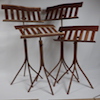Iím planning on building a coffee table using four maloof joints to connect the legs (always wanted to try the joint). I was thinking about how to ensure the top stays flat and may have a great (or potentially stupid) idea.
what about basically using a sliding dovetail, but planing it flush after the fact? I would otherwise do breadboard ends but I think that might look silly with the maloof joints.
is this a good idea or would the dovetail not add the amount of stability Iím looking for?




 Reply With Quote
Reply With Quote






